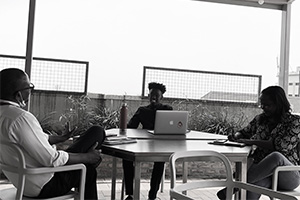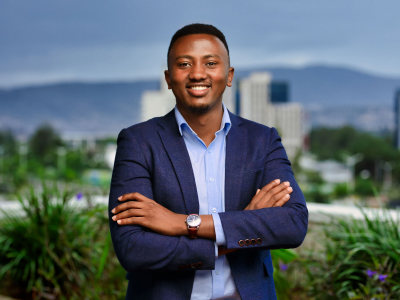Short on time? Here’s the “TL;DR” version of our top lessons to get the most out of interviewing people:
- Frame the conversation
- Be an active listener
- Do your research
- Practice makes perfect
- Be willing to learn
- Get all sides of the story
- Speak the local language
- Debrief and reflect
- Ask open-ended questions
- Ask for feedback

Well-planned and thoughtfully implemented interviews with entrepreneurs, their customers and their suppliers can yield valuable market insights into complex business ecosystems. Interviews are useful to learn about different parts of an ecosystem or value chain, including key actors, system dynamics, opportunities and pain points. These structured conversations enable ecosystem mapping and visualization, and can be used by governments and NGOs to support entrepreneurial investments; by universities to conduct entrepreneurship research; and by business owners and start-ups to identify opportunities, partners and resources.
The Daugherty Water for Food Global Institute (DWFI) team in Rwanda has conducted dozens of interviews to understand the irrigation ecosystem for smallholder farmers, using methods that blend customer discovery — developed by Steve Blank and Giff Constable — and informational interviews — used for professional development and networking. We call the combination of these methods discovery interviews, and we’ve adapted the approach to our context in Rwanda.
We’ve reflected on our experiences testing different ways to have discovery interviews and put together our best tips below. This is the start of a new and necessary discussion; we’re not aware that anyone has previously written up their practice and lessons learned about how to talk with entrepreneurial ecosystem actors in Africa. This isn’t intended as a comprehensive how-to guide — instead, we’ll release more related content in the coming months.
Our reflections below are broken into a three-part framework based on the actions required for a discovery interview: Frame, Interview and Follow-up. “Frame” refers to preparation done before you start the interview, like setting goals, brainstorming questions and doing research. “Interview” includes strategies to effectively steer the conversation to acquire useful information. Finally, “Follow-up” includes debriefing, thank you emails and paving a way for future conversations. As Michael Phelps, the 23-time swimming Olympic gold medalist, once said, “It’s not how you start, but it’s how you finish.” The follow-up work is just as important as the parts preceding it.
Frame (before the conversation):
Knowing someone who is well-connected across the board makes it easier to find initial contacts in a network. One of the first key steps to having meaningful conversations is finding the right person with the right contacts in the ecosystem of interest. Our team in Rwanda includes Grace Mukarusagara. She has worked in the irrigation sector in Rwanda for more than 10 years. Grace has many connections across the ecosystem, and this gave us a ready link to various contacts.
After identifying the people you want to talk to, set clear objectives for your conversation and frame the questions around your objectives. The goal could be as simple as understanding company X’s relationship with its suppliers or the relationship with its customers. You should frame your questions in a way that shows a genuine interest in what the companies or organizations do. Examples could be: “Your supply chain is really interesting to me. Could you tell me why and how you started working with your suppliers?” or “I am interested to know the important factors you focus on when choosing your suppliers.”
As you plan for your interview, we recommend that two people conduct interviews with one person at a time. One interviewer should focus on asking questions while their partner focuses on writing notes. The notetaker can then ask follow-up questions at the end of the interview. We found this process works best to establish rapport and focus with the interviewee. Having just one person asking and answering questions reduces distractions and confusion. Two people might ask two different questions or be jumping in at the same time. Also, having a dedicated note-taker ensures you pick up the key information interviewees share with you.
Furthermore, we found that it is useful to do some research on websites or social media platforms to find information on the person/company you want to talk to at least a day before the interview. This helped us come up with some good and focused questions. Also, if you want your interviewee to feel comfortable, you may ask them for their preferred venue or language. In our case, we started off using English but quickly realized that people were more comfortable using the local language, so we switched.
Interview (during the conversation):
Approaching the interview with a sense of curiosity will let people loosen up and share valuable information. We initially had concerns that people may not want to talk about their failures and challenges. Surprisingly, as we learned to ask questions with sincere curiosity, people opened up to tell us about the challenges and mistakes that led to failure of certain products or services of their businesses. You will get better with asking the right questions over time when you take every conversation as a learning moment.
When posing questions, you should always seek to ask open-ended questions because they give the interviewee a chance to tell stories and share deep insights and experiences. From our experience, asking “yes” or “no” questions, such as “Do you have suppliers?,” doesn’t fit the purpose of a discovery interview and is much less likely to produce any useful information. However, asking open-ended questions such as “Why did you choose to work with this particular supplier?” will give you a profound understanding of a person’s decision-making process.
It important to note that every interview will look different, so you should prepare to adjust to each situation. Actively listening and paying attention to non-verbal cues allows you to understand what your interviewee is not comfortable sharing with you, so you can steer away from sensitive topics. Additionally, it may take you 10 interviews or even more to start getting comfortable with asking questions and understanding where you need to follow-up for clarity. Early on, we had some issues with people not opening up. But as time went on, we learned to ask open-ended questions that encouraged people to tell stories and share useful information.
As you wrap up the interview, thank the interviewee for taking their time to talk with you. It is a great practice to end the conversation with questions like “What should we have asked you?” and “Based on our conversation, are there other people you would recommend we talk with?” This gives you an opportunity to ask the interviewee if he or she would be willing to make an introduction for you, and thus expand your network. If they agree, remember to follow-up with them about it in your “thank you” email. Also, people are often interested in the results of your study, and you should let them know if you are going to share the findings. However, if you make any commitment to share information, you should always make sure to follow through.
Follow-up (after the conversation):
Shortly after each interview, sit down with your partner to talk about what went well and what didn’t and how to improve moving forward. Also, talk over what was learned and each person should summarize what they heard and what they thought was most important. This helps you to combine the key insights and themes from the various aspects of the conversation. We strongly recommend that the note-taker write a summary of the interview within 24 hours to make sure nothing falls through cracks as the days pass by.
In addition, decide on who will send the thank you email. When writing the thank you email, it is a great practice to point out some highlights of the conversation you found most interesting. After debriefing as a pair, ask someone who did not participate in the interview to look over your summary notes and give you feedback. An outside reader might point out a specific answer you could have followed up on and this would be a good opportunity to ask as a follow-up in the thank you email. This is why we usually send our notes over to the rest of our team for feedback. Last but not least, avoid drawing conclusions based on one interview and instead, explore more and ask other stakeholders to get all sides of the story.
We hope you find any of these tips useful in your own conversations. Do you have any experiences or tips you’d like to share with us? We would love to hear about them!
About the Author
Polly Musayidizi joined the Daugherty Water for Food Global Institute as an intern in May 2019 and then full-time as a consultant in August 2020. His interest and expertise lies in entrepreneurial capacity building, leadership and geospatial analyses. As a program consultant for DWFI, Polly contributes to strengthening the agricultural value chain for smallholder farmers in Sub-Saharan Africa through implementing research and capacity building programs.
Polly graduated from the University of Nebraska-Lincoln (UNL) in May of 2020 with a bachelor’s degree in integrated science with minors in mechanized systems management, precision agriculture, leadership and entrepreneurship. In addition to his studies, he served in leadership roles in various agricultural and leadership student organizations at UNL.
Connect with Polly
LinkedIn
Email


